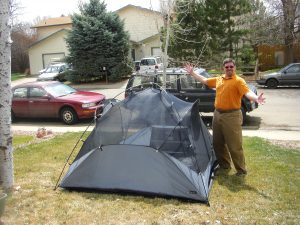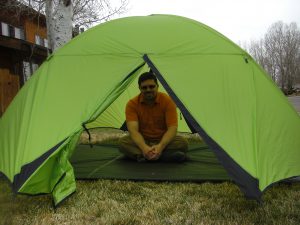A New “Addition” to the Family

That’s right, Jess and Phoebe and I are celebrating spring and the advent of summer by adding a new member to our family. We’ve been agonizing over the decision since early fall, but with our REI dividend (largely thanks to Grammie and Papppy’s annual Colorado vacation spending spree) and a 20% discount burning a hole in our pockets, we finally pulled the trigger. The new “baby” measures in at about 50 ft2 with a maximum internal height of about 48″ and a delivery weight of just over 6 pounds. As if you couldn’t guess by now, it’s not a child but rather a new tent. After looking at a number of 3-person tents, we finally decided on the Losi by Nemo. Nemo is a relatively new tentmaker whose initial claim to fame was the use of inflatable baffles in place of poles on some ultralight tent models. They now have a pretty complete product line including the Losi, which turns out to be about the lightest 3-person tent on the market—when normalized by usable square footage. So it fits our “more space” requirement pretty well. At about $400.00 retail, cost is roughly on par with similar options from Big Agnes, Black Diamond/Bibler, Mountain Hardwear, MSR, Marmot, and other serious tentmakers. As Phoebe continues to grow (darn it), she’s going to need a bit more space than any of our old 2-person tents afford, and we’re hoping to get out a bunch now that the weather is improving.

Although I can imagine some occasions/places where the new tent may be too big, it’s actually light enough for backpacking the baby-encumbered way (that’s where daddy carries all of the gear while mommy carries the baby and hopefully some of the baby gear). I think it will also be reasonably luxurious for the car camping we’re certain to do over the coming years. We haven’t gotten to spend any quality time in the tent yet, but we did get it set up in the front yard for a quick tryout. Here are some of the initial impressions.
For the initial setup, we put together pretty much everything that came in the bag plus the custom footprint (an extra $50 for those keeping score). Losi also offers an internal floor saver called the Pawprint that attaches to little snaps in the corners of the tent. Although we opted to forgo the additional $55 cost, it would probably be a pretty good investment for those camping with dogs on a regular basis as it should dramatically extend the life of the floor. Like many modern tents, the main pole assembly is a hubbed monstrosity that seems bulkier and more complicated than the old-school poles of just a decade ago, but these configurations seem to allow for some unique pole geometries and steeper tent walls than most of the old-school designs. This “pole” still collapses into a fairly compact form, but a number of plastic connectors remain permanently attached to the poles—making the entire bundle a bit bulkier than it would otherwise be. Since pretty much every manufacturer is going this route, it seems we’ll all have to get used to these new designs eventually.

The most unusual design feature is Nemo’s decision to use DAC’s new Jake’s foot for the pole-end attachments. If you haven’t seen this attachment before, don’t feel bad, as there aren’t many tents making use of the plastic widget yet. Basically, the Jake’s foot replaces the traditional pole end and grommet attachment by using a ball (pole-end) and socket (tent) type joint. This is actually one of the features that left Jess and I with the greatest skepticism and concern regarding the purchase. The major benefits are easier setup (a claim I find a bit dubious) and improved freedom of motion. The latter benefit seems legitimate, but I’m not sure it actually translates into a real improvement in terms of the tent’s performance. Perhaps time will tell. Regardless, we’d have been less hesitant in purchasing the Losi if it had a traditional pole-tent attachment—I’ve never seen one of those fail in the field. For the weight conscious, here’s the breakdown:
- Tent Body – 2.41 lbs.
- Fly – 1.80 lbs.
- Hubbed Main Pole – 1.10 lbs.
- Remaining Poles (2) – 0.30 lbs.
- Stakes (8) – 0.21 lbs.
- Stuff Sack – 0.49 lbs.
- Repair Kit – 0.12 lbs.
- Total Packaged – 6.73 lbs.
- Footprint – 0.87 lbs.
- Footprint Stuff Sack – 0.05 lbs.
- Realistic – 6.69 lbs.
- Fast-Packing – 3.93 lbs.
All weights courtesy of Jess’s digital kitchen scale.The realistic weight is for the tent, fly, footprint, poles, and stakes without the stuff sacks and repair kit. The fast-packing weight is for just the footprint, fly, main hubbed pole assembly, and 6 of the 8 stakes packaged with the tent.

The initial tent pitch was pretty straightforward. Although we’d set it up a couple of times in the store, we still learned a few things when we downloaded the manual (not packaged with the tent). One thing we didn’t learn was how to position the footprint. The first time out of the box we had the footprint in the wrong orientation. The tent is symmetric, but the length and width dimensions are pretty different. The alignment error wasn’t obvious until we attached all of the tent clips to the poles and thought things looked a little funny. After rotating the footprint 90 degrees (which was easy to do without taking the tent down), we adjusted the stakes and everything seemed much better. We staked out the fly and climbed into the tent. Jess observed that there is an awful lot of mesh, and I can tell she’s a little concerned that it won’t be as warm as our 2-person mountaineering tent. Of course, she’s absolutely right, and it won’t be quite as strong either. But it is about 4 pounds lighter and almost twice the size, so this isn’t exactly an apples-to-apples comparison. After getting the normal setup out of the way, I was curious to see how the fast-packing setup would go.

Despite owning several tents, this is the first time I’ve ever purchased a custom footprint. Like most modern tents, the manufacturer’s footprint facilitates the so-called fast-packing option whereby the footprint, pole-set, and fly are pitched without the tent. In the case of the Jake’s foot, you have to remove the little plastic widget that the poles attach to from the tent body and attach them to the footprint. At first this seemed like a major pain in the butt, but it turns out to be pretty painless. Nevertheless, for those who frequently go back and forth between setup styles, it could be worthwhile to buy a second set of Jake’s feet. They run about $5.00 apiece and the tent comes with a replacement in the repair kit, so you’d only need to buy 3 of them. As is usually the case, the fast packing setup saves a fair bit of weight and bulk over the complete setup with the only real trade-off being a reduction in bug-proofing. This isn’t actually a big deal in Colorado where the bugs are generally pretty mild, but could be an invitation for disaster in other climes. Pete and I made extensive use of this approach with the Bronski family’s Sierra Designs tent during our 4-day, self-supported bike-packing ride along Kokopelli’s trail from Fruita to Moab (Day 1, 2, 3, & 4) and it worked quite well.
When Jess and I tried setting up the Nemo in this configuration, we discovered that you really only need the main hubbed pole assembly for a decently taut pitch. In fact, I can’t really figure out how you’re supposed to use the 2 auxiliary poles in this configuration as there isn’t an attachment on the fly’s underside to accommodate the ball-ended beauties. So, I’ll just leave them at home in order to save even more weight and bulk over the manufacturer’s listed fast-packing weight.
Overall we’re pretty happy with the tent. It has two doors, so it should be easier for either of us to scramble in and out of the tent without disturbing the other (or Phoebe). It’s spacious enough to feel comfortable on car camping trips where weight isn’t a big concern, and it’s still light enough to take into the back country. I really like the green color, which is a big change from all of our yellowish tents, and Jess is excited about the nifty organizer pocket that hangs inside either end of the tent. She especially likes the built-in diffuser that allows a headlamp stuffed into the pocket to illuminate the tent. We’ll see how well that feature works when we test out the Losi for real. We’re hoping to get out somewhere next weekend, weather permitting, so look for an update soon.



2 Comments
Emily
Looking forward to seeing this beauty in action!
Nat Lake
Where did you purchase the extra Jake’s Feet?